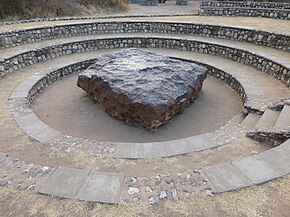
Back Hoba-meteoriet Afrikaans نيزك هوبا Arabic نيزك هوبا (نيزك) ARZ Hoba meteoriti Azerbaijani Гоба (метэарыт) Byelorussian Гоба (мэтэарыт) BE-X-OLD Хоба Bulgarian হোবা উল্কাপিন্ড Bengali/Bangla Meteorit Hoba Czech Hoba-meteoritten Danish
| Hoba | |
|---|---|
 The meteorite in 2014 after becoming a tourist attraction | |
| Type | Iron |
| Class | 12 |
| Country | Namibia |
| Coordinates | 19°35′32″S 17°56′01″E / 19.59222°S 17.93361°E |
| Fall date | Less than 80,000 years ago |
| Found date | 1920 |
The Hoba[1] (/ˈhoʊbə/ HOH-bə) meteorite is named after the farm Hoba West, where it lies, not far from Grootfontein, in the Otjozondjupa Region of Namibia. It has been uncovered, but because of its large mass, has never been moved from where it fell. The main mass is estimated at more than 60 tonnes.[1] It is the largest known intact meteorite (as a single piece)[2] and about twice as massive as the largest fragment of either the Cape York meteorite's 31-tonne Ahnighito kept in the American Museum of Natural History or the Campo del Cielo's 31-tonne Gancedo in Argentina. It is also the most massive naturally occurring piece of iron (actually ferronickel) known on Earth's surface. The name Hoba comes from a Khoekhoegowab word meaning 'gift'.[3] Following its donation to the government in 1987, a visitor centre was constructed with a circular stone access and seating area.
- ^ a b Meteoritical Bulletin Database: Hoba
- ^ McSween, Harry (1999). Meteorites and their parent planets (2nd ed.). Cambridge: Cambridge University Press. ISBN 0521583039. OCLC 39210190.
- ^ Cassidy, Joseph (2009). Place Names of Namibia A Historical Dictionary. Windhoek: Macmillan Education Namibia Publishers (Pty) Ltd. p. 37. ISBN 978-99916-0-654-5.
© MMXXIII Rich X Search. We shall prevail. All rights reserved. Rich X Search